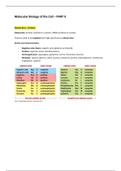Molecular Biology of the Cell – PART II
Stanley Brul – Proteins
Eukaryotes: protein synthesis in cytosol, mRNA synthesis in nucleus
Proteins need to be targeted with high specificity to cellular sites
Amino acid characteristics:
- Negative side chains: aspartic acid, glutamic acid (acids)
- Positive: arginine, lysine, histidine (basic)
- Uncharged polar: asparagine, glutamine, serine, threonine, tyrosine
- Nonpolar: alanine, glycine, valine, leucine, isoleucine, proline, phenylalanine, methionine,
tryptophan, cysteine
,Amino acids encoded by triplets in the mRNA:
- 29 tRNAs plus 16 wobble tRNAs
- Always read from 5’ to 3’ > for example:
• Leucine triplet in DNA strand: 5’-TAA-3’
• Leucine triplet in mRNA (codon): 5’-UUA-3’
• Leucine triplet in tRNA (anti-codon): 5’-UAA-3’
- 5’ to 3’ synthesis of DNA and RNA driven by editing function
(proofreading) of polymerases and energy needs of synthesis:
,Amino acids can be non-essential, essential and strictly essential:
- 9 (strictly) essential amino acids:
• Basic: lysine (K), histidine (H)
• Uncharged polar: threonine (T)
• Nonpolar: valine (V), methionine (M), tryptophan (W), leucine (L), isoleucine (I),
phenylalanine (F)
➢ Mnemonic: Very Frequently I Work Like Mr T.K. Haris (VFIWLMTKH)
Proline:
- No primary amino acid > imino acid (C=NH instead of NH2)
- Helix breaker (hinge) > often present at domain edges
, Amino acids formed post-translationally:
Peptide bond formed between amino-terminus (NH2) of amino acid bound to the tRNA and the carboxy-
terminus (COO) of the nascent chain
Polypeptide chain folds as it grows:
Proteins can reversibly fold and unfold into tertiary conformation:
- Hydrophobic core region contains nonpolar side chains
- Cells will respond to proteins in which hydrophobic groups are exposed
- Folding determined by inter- and intra-molecular interactions (electrostatic attractions,
hydrogen bonds, van der Waals attractions)






